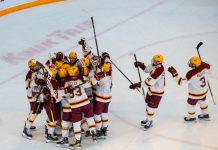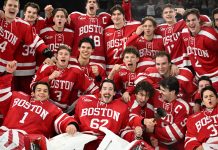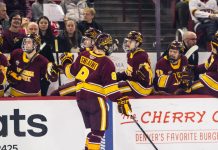The nation’s capital exemplifies a common duality between hockey and pro hockey. Like April’s cherry trees, D.C.’s interest in the professional team, the Washington Capitals, has been blooming all over, but the region’s hockey awareness tends to stop at the letters N.H.L.
That presented a challenge to the Greater Washington Sports Alliance (GWSA) and the NCAA in marketing the Frozen Four.
The nation’s seat-of-government isn’t a traditional hockey market, despite its reasonably northeastern location. Its coldest month of the year, January, averages a balmy 34 degrees, and natural sustained freezes are extremely rare. Therefore, the more frigid traditions associated with frozen ponds and backyard rinks are unknown so close to the Mason-Dixon Line.
On the pro side of things, the Caps were borne of the NHL’s greatest expansion era, commencing play in 1974. The team was solid and made frequent playoff pushes through the 1980s and ’90s, but while their Alexander Ovechkin-led resurgence vaulted them into the playoffs last year, they had missed the postseason each of the previous five years.
Youth hockey has taken hold in the wake of the Caps’ reawakening, with nearly a dozen year-round rinks in the greater Washington area. Maryland, Navy, Georgetown, Virginia, Virginia Tech, American, George Mason and George Washington, among others, each boast ACHA club hockey teams, but Princeton is the nearest D-I program.
It’s not surprising, therefore, that recognition of college hockey’s ultimate event differs greatly, depending on who and where you inquire.
Signage for the event was heavy on the block of the Verizon Center, with lightpost banners, scrolling marquees and multitudes of advertising and merchandise on display in the arena’s street-front windows, but apart from bars and restaurants welcoming NCAA hockey business with chalkboard signs on the street, there was little to be seen as few as a dozen yards from the venue. The Washington Mall appeared devoid of flags, signs or banners, despite being a short half-dozen blocks from the arena.
On the other hand, as far away as northern Virginia there was Frozen Four merchandise available at the Kettler Capitals Iceplex, the practice site and headquarters for the NHL organization. While a hotel concierge a half-mile from the games professed to have no knowledge whatsoever about the Frozen Four, the college-aged attendant at the Iceplex on Friday knew all about it, correctly naming the participants and even Thursday night’s winners. Perhaps it helped that one of his best friends plays for Rensselaer.
The marketing strategy, according to GWSA vice president Chris Browne, was primarily hockey-centric. The local focus was on hitting area rinks and youth organizations, getting the word out that the D.C.’s first-ever NCAA championship event was going on and that tickets were available. From an attendance perspective, most Frozen Fours are tap-in: only 2,500 tickets were made available for walk-up or local consumption, with the rest going to the participating schools and other NCAA member institutions. Apart from selling those few seats, Browne & Co. were mostly interested in generating awareness of the event.
Side events organized by the GWSA included the annual skills competition on Friday night, but also a youth clinic at the Iceplex on Saturday morning and an open-skate on the Verizon’s sheet early that afternoon; both were very well attended.
So what’s to be made of this quirky little hockey community? It may not be the most overwhelmingly appreciative and understanding site in the Frozen Four’s illustrious history, but the NCAA looking for a return trip to the District would be, well, a capital idea.


